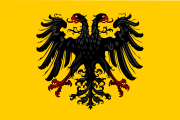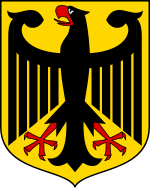Otto I, Holy Roman Emperor
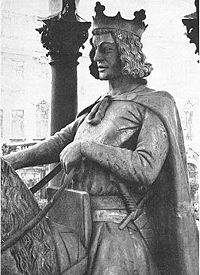
Otto I the Great (23 November 912 – 7 May 973), son of Henry I the Fowler and Matilda of Ringelheim, was Duke of Saxony, King of Germany, King of Italy, and "the first of the Germans to be called the emperor of Italy" according to Arnulf of Milan.[1] While Charlemagne had been crowned emperor in 800, his empire had been divided amongst his grandsons, and following the assassination of Berengar of Friuli in 924, the imperial title had lain vacant for nearly forty years. On 2 February 962, Otto was crowned Emperor of what would later become the Holy Roman Empire.
Contents |
Early reign
Otto succeeded his father as king of the Germans in 936. He arranged for his coronation to be held in Charlemagne's former capital, Aachen, where he was anointed by the archbishop of Mainz, primate of the German church. According to the Saxon historian Widukind of Corvey, at his coronation banquet he had the four other dukes of the empire, those of Franconia, Swabia, Bavaria and Lorraine, act as his personal attendants: Arnulf I of Bavaria as marshal (or stablemaster), Herman I, Duke of Swabia as cupbearer (lat. pincerna or buticularius), Eberhard III of Franconia as steward (or seneschal), and Gilbert of Lorraine as Chamberlain. Thus from the outset of his reign he signalled that he was the successor to Charlemagne, whose last heirs in East Francia had died out in 911, and that he had the German church, with its powerful bishops and abbots, behind him. Otto intended to dominate the church and use that sole unifying institution in the German lands in order to establish an institution of theocratic imperial power. The Church offered wealth, military manpower and its monopoly on literacy. For his part the Emperor offered protection against the nobles, the promise of endowments, and an avenue to power as his ministeriales.
In 938, a rich vein of silver was discovered at the Rammelsberg in Saxony. This mineral wealth helped fund Otto's activities throughout his reign; indeed, it would provide much of Europe's silver, copper, and lead for the next two hundred years.
Otto's early reign was marked by a series of ducal revolts. In 938, Eberhard, the new duke of Bavaria, refused to pay Otto homage. After Otto deposed him in favor of his uncle Berthold, Eberhard of Franconia revolted, together with several of the Saxon nobility, who tried to replace Otto with his elder half-brother Thankmar (son of Henry's first wife Hatheburg). While Otto was able to defeat and kill Thankmar, the revolt continued the next year when Gilbert, the duke of Lorraine, swore fealty to King Louis IV of France. Meanwhile, Otto's younger brother Henry conspired with Frederick, Archbishop of Mainz, to assassinate him. The rebellion ended in 939 with Otto's victory at the Battle of Andernach, where the dukes of Franconia and Lorraine both perished. Henry fled to France, and Otto responded by supporting Hugh the Great in his campaign against the French crown, but in 941 Otto and Henry were reconciled through the efforts of their mother, and the next year Otto withdrew from France after Louis recognized his suzerainty over Lorraine.
To prevent further revolts, Otto arranged for all the important duchies in the German kingdom to be held by close family members. He kept the now-vacant duchy of Franconia as a personal fiefdom, while in 944 he bestowed the duchy of Lorraine upon Conrad the Red, who later married his daughter Luitgard. Meanwhile, he arranged for his son Liutdolf to marry Ida, the daughter of Duke Herman of Swabia, and to inherit that duchy when Herman died in 947. A similar arrangement led to Henry becoming duke of Bavaria in 949.
Campaigns in Italy and eastern Europe
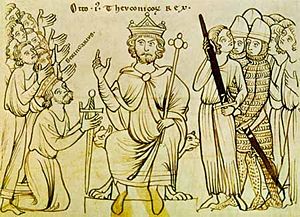
Meanwhile, Italy had fallen into political chaos. On the death (950), possibly by poisoning, of Lothair of Arles, the Italian throne was inherited by a woman, Adelaide of Italy, the respective daughter, daughter-in-law, and widow of the last three kings of Italy. A local noble, Berengar of Ivrea, declared himself king of Italy, abducted Adelaide, and tried to legitimize his reign by forcing Adelaide to marry his son Adalbert. However, Adelaide escaped to Canossa and requested German intervention. Luidolf and Henry independently invaded northern Italy to take advantage of the situation, but in 951 Otto frustrated his son's and his brother's ambitions by invading Italy himself. He received the homage of the Italian nobility, assumed the title "King of the Lombards" and in 952 forced Berengar and Adalbert to pay homage, allowing them to rule Italy as his vassals. Having been widowed since 946, he married Adelaide himself.
When Adelaide bore a son, Liudolf feared for his position as Otto's heir. In 953 he rebelled in league with Conrad, Duke of Lorraine and the Archbishop of Mainz. While Otto was initially successful in reasserting his authority in Lorraine, he was captured while attacking Mainz, and by the next year, the rebellion had spread throughout the kingdom. However, Conrad and Liudolf erred by allying themselves with the Magyars. Extensive Magyar raids in southern Germany in 954 compelled the German nobles to reunite, and at the Diet of Auerstadt, Conrad and Luitdolf were stripped of their titles and Otto's authority reestablished. In 955, Otto cemented his authority by routing Magyar forces at the Battle of Lechfeld (10 August 955) and the Obodrites at the Battle of Recknitz (16 October 955).
The Ottonian system

Mgft. = march/margraviate
Hzt. = duchy
Kgr. = kingdom
As a key element of his domestic policy, Otto sought to strengthen ecclesiastical authorities, chiefly bishops and abbots, at the expense of the secular nobility who threatened his own power. To control the forces that the Church represented, Otto made consistent use of three institutions. One was the royal investiture of bishops and abbots with the symbols of their offices, both spiritual, for Otto was the anointed King of the Germans, and temporal, in which Otto secured his bishops and abbots as his vassals through a commendation ceremony. "Under these conditions clerical election became a mere formality in the Ottonian empire, and the king filled up the ranks of the episcopate with his own relatives and with his loyal chancery clerks, who were also appointed to head the great monasteries" (Cantor, 1994 p. 213). The second institution was more securely established in Ottonian territories, that of the proprietary churches (Eigenkirchen; in English law the right of "advowson"). In German law, any structure built on land owned by a lord belonged to that lord, unless a charter had very specifically conveyed away those rights. Otto and his chancery aggressively reclaimed proprietary rights over many landed churches and abbeys. The third instrument of Ottonian power was the system of the advocatus (German Vogt). The advocatus was a secular manager of ecclesiastical estates, who was entitled to a certain share of the agricultural produce and other revenues and was responsible for safety and good order. Unlike countships, which quickly became hereditary, the Vogt performed the duties of a West Frankish bailli and held his position solely at the continued will of the emperor whom he served.
Otto endowed the bishoprics and abbeys with large tracts of land, over which secular authorities had neither the power of taxation nor legal jurisdiction. In an extreme example, when Conrad the Red was stripped of his ducal title in Lorraine, Otto appointed his brother Bruno – already the Archbishop of Cologne – as the new duke of Lorraine. In the lands Otto conquered from the Wends and other Slavic peoples on his eastern borders, he founded several new bishoprics.
Because Otto personally appointed the bishops and abbots, these reforms strengthened his central authority, and the upper ranks of the German church functioned in some respect as an arm of the imperial bureaucracy. Conflict over these powerful bishoprics between Otto's successors and the growing power of the Papacy during the Gregorian Reforms would eventually lead to the Investiture Conflict and the undoing of central authority in Germany in the 11th century.
The Ottonian Renaissance
A limited renaissance of the arts and architecture depended on court patronage of Otto and his immediate successors. The "Ottonian Renaissance" was manifest in some revived cathedral schools, such as that of Bruno I, Archbishop of Cologne, and in the production of illuminated manuscripts, the major art form of the age, from a handful of elite scriptoria, such as that at Quedlinburg Abbey, founded by Otto in 936. The Imperial abbeys and the Imperial court became the centers of religious and spiritual life, led by the example of women of the royal family. Scandalized by the state of the liturgy in Rome, Otto commissioned the first ever Pontifical Book, a liturgical book containing both prayers and ritual instruction. The compilation of the Romano-Germanic Pontifical, as it is now called, was overseen by Archbishop William of Mainz.
Imperial title
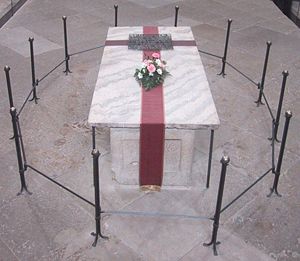
In the early 960s, Italy was again in political turmoil, and when Berengar occupied the northern Papal States, Pope John XII asked Otto for assistance. Otto returned to Italy and on February 2 962, the pope crowned him emperor. See Translatio imperii. Ten days later, the pope and emperor ratified the Diploma Ottonianum, under which the emperor became the guarantor of the independence of the papal states. This was the first effective guarantee of such protection since the Carolingian Empire. After Otto left Rome and reconquered the Papal States from Berengar, however, John became fearful of the emperor's power and sent envoys to the Magyars and the Byzantine Empire to form a league against Otto. In November 963, Otto returned to Rome and convened a synod of bishops that deposed John and crowned Leo VIII, at that time a layman, as pope. When the emperor left Rome, however, civil war broke out in the city between supporters of the emperor and of John. John returned to power amidst great bloodshed and excommunicated those who had deposed him, forcing Otto to return to Rome a third time in July 964 to depose Pope Benedict V (John having died two months earlier). On this occasion, Otto extracted from the citizens of Rome a promise not to elect a pope without imperial approval.
Otto unsuccessfully campaigned in southern Italy on several occasions from 966 to 972. In 967, he gave the duchy of Spoleto to Pandulf Ironhead, prince of Benevento and Capua, a powerful ally in the Mezzogiorno. In the next year (968) Otto left the siege of Bari in the charge of Pandulf, but the allied duke was captured in the battle of Bovino by the Byzantines. In 972, the Byzantine emperor John I Tzimisces recognized Otto's imperial title and agreed to a marriage between Otto's son and heir Otto II and his niece Theophano. Pandulf was released from captivity.
After his death in 973 he was buried next to his first wife Edith of Wessex in the Cathedral of Magdeburg.
See also
- Emperor Otto I was recently selected as the main motif for a high value commemorative coin, the €100 Imperial Crown of the Holy Roman Empire commemorative coin, minted in 2008. The obverse shows the Imperial Crown of the Holy Roman Empire. The reverse shows Emperor Otto I with old St. Peter's Basilica in Rome in the background, where his coronation took place.
- Kings of Germany family tree. He was related to every other king of Germany.
Notes
- ↑ Arnulf,Liber gestorum recentium, I.7.
References
- Charter given by Emperor Otto for the monastery Hilwartshausen showing the Emperor's seal, 12.2.960. Taken from the collections of the Lichtbildarchiv älterer Originalurkunden at Marburg University
Further reading
- Schneidmüller, Bernd. "Otto I." In Die deutschen Herrscher des Mittelalters. Historische Porträts von Heinrich I bis Maximilian I (919–1519), ed. Bernd Schneidmüller and Stefan Weinfurter. Munich, 2003. 35–61. ISBN 3-406-50958-4.
- Laudage, Johannes. Otto der Große: (912–973). Eine Biographie. Regensburg, 2001. ISBN 3-7917-1750-2.
- Althoff, Gerd. "Otto I. der Große." In Neue Deutsche Biographie (NDB) 19. Berlin, 1999. 656–60. Available here
- Althoff, Gerd and Hagen Keller. Heinrich I. und Otto der Grosse: Neubeginn auf karolingischem Erbe. Göttingen, 1985.
- Hiller, Helmut. Otto der Große und seine Zeit. Munich, 1980. ISBN 3-471-77847-0.
- Wies, Ernst W. Otto der Große. Kämpfer und Beter. 3d ed. Esslingen and Munich, 1998. ISBN 3-7628-0483-4.
|
Otto I, Holy Roman Emperor
House of Saxony (Liudolfing)
Born: 936 Died: 973 |
||
| German royalty | ||
|---|---|---|
| Regnal titles | ||
| Preceded by Henry I |
King of Germany 936–973 |
Succeeded by Otto II |
| Vacant
Title last held by
Berengar of Friuli |
Holy Roman Emperor 962–973 |
|
| Preceded by Berengar II |
King of Italy 951–973 |
|
| Preceded by Henry I |
Duke of Saxony 936–961 |
Succeeded by Hermann |
|
||||||||||
|
||||||||||||||||||||||||||||
| Persondata | |
|---|---|
| NAME | Otto I the Great |
| ALTERNATIVE NAMES | |
| SHORT DESCRIPTION | Holy Roman Emperor |
| DATE OF BIRTH | November 23, 912 |
| PLACE OF BIRTH | |
| DATE OF DEATH | May 7, 973 |
| PLACE OF DEATH | |
